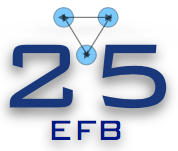Conveners
Thursday Parallel Session: Few-body systems and halo nuclei (Linke Aula)
- Tom Aumann
The 11Be neutron halo nucleus decays into 10Be with a rate that exceeds expectations. Neutron disappearance into dark matter, beta decay of a halo neutron, or beta delayed proton decay have been offered as explanations. The discovery of an exotic near-threshold resonance supports the latter. The observations, however, also highlight a remarkable and not fully understood...
Due to their large spatial extension, two-neutron halo nuclei display a significant enlargement in the low-energy $E1$ strength distribution parameterizing the Coulomb dissociation cross section. Thereby the $E1$ strength is an important observable for halo nuclei, and by comparing theoretical calculations with experimental data, we can test our understanding of these exotic nuclear...
Generalization of the Wilsonian renormalization group approach to few-body problems by introducing a multitude of cutoff parameters has been suggested in Ref. [1]. In the framework of an effective field theory, similarly to the Gell-Mann and Low renormalization group, this approach offers the freedom of choosing optimal renormalization scheme in multi-dimensional space of renormalization scale...
The leading-order (LO) Halo EFT interactions for shallow states beyond $S$-waves exhibit non-negligible energy dependencies leading to difficulties related to the normalization. Recently, purely momentum-dependent potentials with square-root form factors have been investigated for the NN and the 3N system [e.g., S. R. Beane et al. (2022), R. Peng et al. (2022) , V. S. Timoteo et al. (2023)]....
We shall introduce a nuclear interaction model with explicit mesons where the nucleons do not interact directly but rather emit and absorb mesons which are treated explicitly on equal footing with the nucleons.
We shall show that the model is able to i) provide a bound neutron-proton state, the deuteron~[1], and ii) adequately describe the threshold pion photo-production off...
A hyperspherical cluster model has been developed to describe long-range behaviour of one particle removed from a few- or a many-body system. It has been applied to the ground and first excited states of helium drops with five, six, eight and ten atoms interacting via a two-body soft gaussian potential. Convergence of the hyperspherical cluster harmonics expansion is studied for binding...

